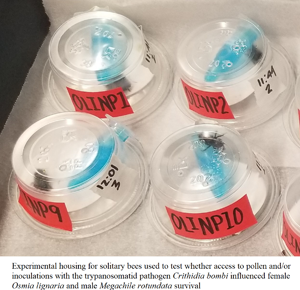Crossref Citations
This article has been cited by the following publications. This list is generated based on data provided by
Crossref.
Davis, Abby E.
Deutsch, Kaitlin R.
Torres, Alondra M.
Mata Loya, Mesly J.
Cody, Lauren V.
Harte, Emma
Sossa, David
Muñiz, Paige A.
Ng, Wee Hao
and
McArt, Scott H.
2021.
Eristalis flower flies can be mechanical vectors of the common trypanosome bee parasite, Crithidia bombi.
Scientific Reports,
Vol. 11,
Issue. 1,
Nanetti, Antonio
Bortolotti, Laura
and
Cilia, Giovanni
2021.
Pathogens Spillover from Honey Bees to Other Arthropods.
Pathogens,
Vol. 10,
Issue. 8,
p.
1044.
Figueroa, Laura L.
Compton, Sally
Grab, Heather
and
McArt, Scott H.
2021.
Functional traits linked to pathogen prevalence in wild bee communities.
Scientific Reports,
Vol. 11,
Issue. 1,
Palmer-Young, Evan C.
Markowitz, Lindsey M.
Grubbs, Kyle
Zhang, Yi
Corona, Miguel
Schwarz, Ryan
Chen, Yanping
and
Evans, Jay D.
2022.
Antiparasitic effects of three floral volatiles on trypanosomatid infection in honey bees.
Journal of Invertebrate Pathology,
Vol. 194,
Issue. ,
p.
107830.
Fowler, Alison E.
Giacomini, Jonathan J.
Connon, Sara June
Irwin, Rebecca E.
and
Adler, Lynn S.
2022.
Sunflower pollen reduces a gut pathogen in the model bee species,
Bombus impatiens
, but has weaker effects in three wild congeners
.
Proceedings of the Royal Society B: Biological Sciences,
Vol. 289,
Issue. 1968,
Palmer-Young, Evan
Markowitz, Lindsey M.
Grubbs, Kyle
Zhang, Yi
Corona, Miguel
Schwarz, Ryan
Chen, Yanping
and
Evans, Jay D.
2022.
Antiparasitic Effects of Three Floral Volatiles on Trypanosomatid Infection in Honey Bees.
SSRN Electronic Journal ,
Orlova, Margarita
Porter, Monique
Hines, Heather M.
and
Amsalem, Etya
2022.
Symptomatic Infection with Vairimorpha Bombi Decreases Diapause Survival in a Wild Bumble Bee Species (Bombus Griseocollis).
SSRN Electronic Journal ,
Brown, Mark J. F.
2022.
Complex networks of parasites and pollinators: moving towards a healthy balance.
Philosophical Transactions of the Royal Society B: Biological Sciences,
Vol. 377,
Issue. 1853,
URBAN-MEAD, Katherine R.
WALTER, Edward
MCART, Scott H.
and
DANFORTH, Bryan N.
2022.
Nearly half of spring-flying male Andrena bees consume pollen, but less than female conspecifics.
Apidologie,
Vol. 53,
Issue. 4,
Gekière, Antoine
Semay, Irène
Gérard, Maxence
Michez, Denis
Gerbaux, Pascal
and
Vanderplanck, Maryse
2022.
Poison or Potion: Effects of Sunflower Phenolamides on Bumble Bees and Their Gut Parasite.
Biology,
Vol. 11,
Issue. 4,
p.
545.
Jones, Laura J.
Singh, Avehi
Schilder, Rudolf J.
and
López-Uribe, Margarita M.
2022.
Squash bees host high diversity and prevalence of parasites in the northeastern United States.
Journal of Invertebrate Pathology,
Vol. 195,
Issue. ,
p.
107848.
Fowler, Alison E.
Sadd, Ben M.
Bassingthwaite, Toby
Irwin, Rebecca E.
and
Adler, Lynn S.
2022.
Consuming sunflower pollen reduced pathogen infection but did not alter measures of immunity in bumblebees.
Philosophical Transactions of the Royal Society B: Biological Sciences,
Vol. 377,
Issue. 1853,
Tuerlings, Tina
Buydens, Louella
Smagghe, Guy
and
Piot, Niels
2022.
The impact of mass-flowering crops on bee pathogen dynamics.
International Journal for Parasitology: Parasites and Wildlife,
Vol. 18,
Issue. ,
p.
135.
Cohen, Hamutahl
Ponisio, Lauren C.
Russell, Kaleigh A.
Philpott, Stacy M.
and
McFrederick, Quinn S.
2022.
Floral resources shape parasite and pathogen dynamics in bees facing urbanization.
Molecular Ecology,
Vol. 31,
Issue. 7,
p.
2157.
Figueroa, Laura
Sadd, Ben
Tripodi, Amber
Strange, James
Colla, Sheila
Adams, Laurie
Duennes, Michelle
Evans, Elaine
Lehmann, David
Moylett, Heather
Richardson, Leif
Smith, James
Smith, Tamara
Spevak, Edward
and
Inouye, David W.
2023.
Endosymbionts that threaten commercially raised and wild bumble bees (Bombus spp.).
Journal of Pollination Ecology,
Vol. 33,
Issue. ,
p.
14.
Gutierrez, Grace M
LeCroy, Kathryn A
Roulston, T’ai H
Biddinger, David J
López-Uribe, Margarita M
and
Lupi, Daniela
2023.
Osmia taurus (Hymenoptera: Megachilidae): A Non-native Bee Species With Invasiveness Potential in North America.
Environmental Entomology,
Vol. 52,
Issue. 2,
p.
149.
Orlova, Margarita
Porter, Monique
Hines, Heather M.
and
Amsalem, Etya
2023.
Symptomatic Infection with Vairimorpha spp. Decreases Diapause Survival in a Wild Bumble Bee Species (Bombus griseocollis).
Animals,
Vol. 13,
Issue. 10,
p.
1656.
Klocek, Donnamae
Grybchuk, Danyil
Macedo, Diego H.
Galan, Arnau
Votýpka, Jan
Schmid-Hempel, Regula
Schmid-Hempel, Paul
Yurchenko, Vyacheslav
and
Kostygov, Alexei Yu.
2023.
RNA viruses of Crithidia bombi, a parasite of bumblebees.
Journal of Invertebrate Pathology,
Vol. 201,
Issue. ,
p.
107991.
Al-Ghafli, Hawra
and
Barribeau, Seth M
2023.
Double trouble: trypanosomatids with two hosts have lower infection prevalence than single host trypanosomatids.
Evolution, Medicine, and Public Health,
Vol. 11,
Issue. 1,
p.
202.
Blubaugh, Carmen K.
Jones, Cami R.
Josefson, Chloe
Scoles, Glen A.
Snyder, William E.
and
Owen, Jeb P.
2023.
Omnivore diet composition alters parasite resistance and host condition.
Journal of Animal Ecology,
Vol. 92,
Issue. 11,
p.
2175.
